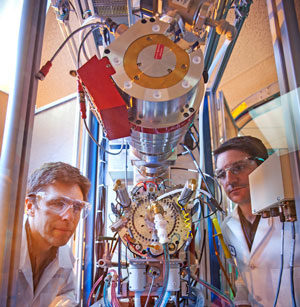Simulations Accelerate Development of Medical Countermeasures
Livermore scientists leverage high-performance computing to predict the outcome of new therapeutic treatments and focus on the most promising compounds.
Accelerated Drug Development
Conventional approaches to drug development can be lengthy and expensive. Drug companies often devote 10 to 15 years and more than a billion dollars to bring a new drug to market.
This extensive investment can act as a powerful disincentive to developing new drug therapies. In addition, pharmaceutical companies are typically unwilling to invest in therapeutics with a small target market.
The focus on achieving an adequate return on investment makes it unlikely that industry will fund the development of medical countermeasures that could benefit our nation’s warfighters, such as antidotes for nerve agents and new types of antibiotics. Combining the expertise of computational biochemists, biomedical scientists, and organic chemists, a team of Livermore researchers is integrating experimental data with high-performance computing (HPC)–based pharmacokinetics modeling to accelerate development of safe and effective medical countermeasures to chemical warfare agents and other hazards.
Predicting Drug Safety and Efficacy
Scientists use Livermore’s HPC resources to screen the safety and efficacy of drug compounds, reducing the time spent on costly laboratory experiments and steamlining the drug discovery process.
For example, computational biochemists use HPC to simulate drug-membrane permeability, enabling them to predict how readily compounds will enter cells. Most drugs need to pass through at least one cellular membrane to reach their intended target. Although tight binding of a drug molecule to its intended target is important for potency, poor membrane permeability will likely result in a lack of efficacy.
Using information on a drug candidate’s chemical structure, the team models a compound’s energy profile and diffusion rate. In a matter of hours, they can predict a drug candidate’s membrane permeability.
The team also uses HPC-based virtual screening to predict a compound’s ability to bind to a targeted receptor. Simulations make it possible to predict beneficial and adverse effects of new drugs at the molecular level.
These types of virtual screening predictions allow researchers to focus on the most promising compounds when conducting lab-based in vitro tests to assess a compound’s safety and efficacy. During recent experiments, the Livermore team demonstrated that HPC-based modeling of compounds can dramatically shorten the chemistry phase of drug development from three or four years to a matter of months.
Novel Antibiotics
As existing bacterial strains become resistant to treatment, a growing need exists for developing novel antibiotics. The Livermore research team is using HPC-based modeling and simulations for investigating ways to speed development of a new class of antibiotics.
In collaboration with a commercial partner, Livermore is working to identify antibacterial molecules that can address the challenge of drug resistance. The team is conducting computing-intensive calculations to explore the features of these molecules for antibiotic development.
Leveraging the Forensic Science Center
As they explore more effective methods to predict the outcome of new therapeutic treatments, the research team leverages another unique asset at Livermore—the Forensic Science Center.
The center’s state-of-the-art instrumentation includes high-resolution mass spectrometers coupled to purification systems, such as liquid chromatographs and gas chromatographs. Chemists use this technology to determine if chemical weapons are present in a suspicious material, and to conduct experiments studying the efficacy of promising new drug compounds.






